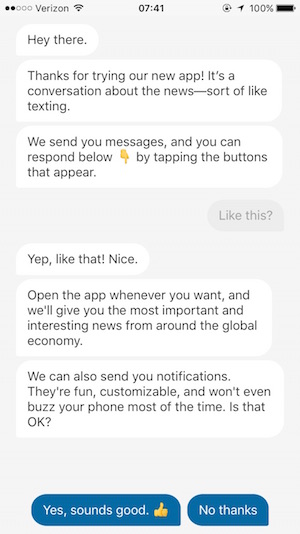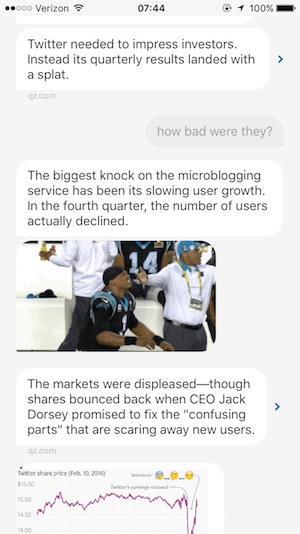
Quartz Brief, the truly original mobile news app built around a chat interface and bots pre-fed with human prose, will die July 1, Digiday has reported. It was 3 years old.
It is survived by a different app that last year took its predecessor’s name — just plain ol’ Quartz — and a lengthy list of laudatory tweets from media people like me.
I’ve been writing about iPhone news apps as long as they’ve existed, and it’s fair to say that the ones produced by news publishers themselves have been consistently boring. Keen to use apps to recreate the directness of their pre-web customer relationships, publishers have mostly made news apps that are just lists of headlines you can tap — perfectly usable, but with innovations only on a small scale.
(Sure, there have been exceptions: NYT Now (aggregating other outlet’s stories, a confined set of content), The Economist’s Espresso (a distinct summary/completion play), the original BuzzFeed News app (a newsletter-y format and creative push notifications), maybe The Daily Beast’s 2014 app (an attempt at gamification), Reuters TV (auto-packaging video clips into “shows”), HuffPost Live and WSJ Live (early tries at TV-like experiences), the South China Morning Post’s Inkstone, and I’m sure a couple others whose product chief will be emailing me shortly because I’ve forgotten them. But that’s all I can think of across a gazillion apps and 10-plus years.)
When the Quartz app debuted in 2016, it was immediately clear that it would be a big step away from the news app mainstream. No list of headlines here; a first-time user saw what looked like a chat interface, familiar from whatever app they use to trade barbs with friends, and a sort of textual uncanny valley: Am I talking with a bot? A person? A news organization?

The developers among us have tried to keep me honest about the limits of this metaphor. In some respects, it’s literally true; in others, it’s just a concept. For the less technical among us, know that an API is how an application speaks to a server to get fresh data for users…Our philosophy has always been to put as little friction as possible between us and our readers, and our API is an advantage in living up to that ideal…
So when we say Quartz is an API, we don’t mean publish once and send it everywhere. We mean Quartz can go anywhere our readers are, in whatever form is appropriate…What’s most striking about that is what sits in the middle: our brand. In this environment, it’s the most important thing: We are a guide to the new global economy for smart, worldly people. That drives our editorial mission, our product vision, and our commercial business. And the specific forms that takes is the challenge we’re all here to tackle.
If you want to hear more about the thinking behind the app, check out this video of him presenting it at the 2016 ISOJ. (Bias alert: Zach was my first hire at Nieman Lab back in 2008.)
2016 was perhaps the peak of publishers’ interest in chat as a distribution vector and as an interface metaphor. The most ambitious news orgs were experimenting with coverage on WhatsApp or WeChat or Facebook Messenger or whatever platform seemed right at the time. A startup named Purple was doing news chat over SMS and building a “messaging-first newsroom.” That spring, Facebook announced new tools to create Messenger bots and news orgs like CNN pounced at the opportunity.
The argument for chat was clear. People spend a lot of time in chat apps, especially young people hard for publishers to reach. If you squinted a little, they looked a lot like other forms of social media that — particularly circa 2016 — were useful distributors of news content and big-league aggregators of audience attention. Chat apps and interfaces were a logical place to try things out.
Some thought this was the beginning of a new subgenre, “conversational journalism.” Felix Salmon declared “messaging is the future of the news brand” and that “for anybody trying to build a news brand today, messaging is clearly the most important new area to conquer.” (The rest of the piece is smarter than that.)
But I think it’s fair to say that chat bubble (sorry) has burst. As the person behind the YouTube video “Why CNN’s Facebook Messenger Chat Bot Sucks” put it: “Does anyone really want news flooding their Messenger?” Or as Simon Owens put it in the YouTube video “I spent several weeks using chatbots for news and they suck”: “Basically they’re just glorified push notifications, except in some ways much worse…It quickly became a chore to even look at them.”
Chat apps — at least as used in the United States; folkways vary widely across countries here — are walled-off spaces for personal communications. Part of the spark for the boom in chat usage is the desire to flee environments like Facebook and Twitter that intermingle personal communication with news stories and all sorts of other content. Chats with your friends operate at their own pace, driven by human conversation; newsbots in chat apps tend toward “HERE ARE FIVE MORE HEADLINES, MY FELLOW KIDS” messages every few hours. They’re a commercial invader in what is probably the most personal space on your phone. So yeah, users don’t seem particularly interested.
Not to mention that the tech companies behind the apps aren’t too sure themselves that they want to become just another inbox with news stories in it. WhatsApp famously made it hard for publishers to broadcast messages in groups larger than 256, and recently it said it would be banning newsletter distribution altogether.
What about attempts that use a chat UI outside of the apps your friends hang out in? Purple never got much traction with users; its tech was acquired earlier this year by theSkimm, which may make better use of it. ResiApp, a German chat-driven news app, shut down last fall. And now Quartz is shutting its chat app down too.
But it is also true that Quartz Brief never attracted a particularly large audience, averaging 23,000 downloads a month. In media circles, there were a lot of people like me who admired the app’s ideas and execution enormously — but also didn’t really use it.
There will continue to be interesting experiments around using chat interfaces in news; they’ll work best in specific niches, they’ll be a challenge to integrate into existing news flows, and they’ll still have to figure out the right balance between personal-but-expensive-to-run and bot-driven-but-not-all-that-good. But who knows? Talk to me in five years and this might have all changed. But my takeaway from all these moves is that there’s little evidence people want to chat with news organizations, at least not at scale, and that trying to nose our way into their private spaces isn’t always appreciated.
“Some people loved it!” one former employee said. “Just not hundreds of thousands of people.” Beloved Quartz news "chat" app to shut down: https://t.co/HTSgNDJNSB
— Chase Gummer ⚓️ (@ChaseGu) June 24, 2019
Quartz is shutting down its Quartz Brief mobile app July 1 https://t.co/6dfgJsTGne via @digiday << a product which was innovative but not so used even back then
— Rafat Ali, Media Operator (@rafat) June 24, 2019
Remember how before podcasts and VR, everyone had to be a chatbot ? "Quartz is shutting down its Quartz Brief mobile app July 1" https://t.co/M1OyOLpHuR via @digiday
— Marie C Beuth (@M_C_B) June 24, 2019
Quartz cierra The Brief, la app que tanto gustó a los periodistas por su estilo conversacional basado en un bot, pero que no tuvo demasiado éxito entre el público general. Ahora se centran en una nueva enfocada en la conversación entre sus usuarios https://t.co/G317dlYy4w
— JoséManuel Rodríguez (@josemanuelrodos) June 22, 2019
Always have been a big fan of the Quartz Brief mobile app experience. Sad to see this couragious product experiment to come to an end. https://t.co/9CXKGRuiyQ
— Benjamin Stoll (@benjsto) June 22, 2019
"The Brief, which earned the adoration of media watchers but never managed to grow a large-scale audience, is being shut down" https://t.co/Z28K9hVmLC via @digiday
— Vincent Baby (@vb2b) June 22, 2019
Machines (or humans pretending to be machines pretending to be humans) are no good at chatting about the news. First to go was @ResiApp, now it's the turn of Quartz Brief. Wondering what's keeping @novibot afloat. https://t.co/TBt8QNqIjz
— rr (@roboreport) June 21, 2019
The era of conversation apps comes to an end. https://t.co/kiGS1kUROO
— Johannes Klingebiel (@Klingebeil) June 24, 2019